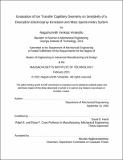Evaluation of Ion Transfer Capillary Geometry on Sensitivity of a Desorption Electrospray Ionization and Mass Spectrometry System
Author(s)
Vinakollu, Nagashumrith Venkata
DownloadThesis PDF (2.837Mb)
Advisor
Hardt, David E.
Terms of use
Metadata
Show full item recordAbstract
This research examines the effect of ion transfer capillary geometry on the sensitivity of the Desorption Electrospray Ionization – Mass Spectrometry (DESI-MS) process. Previous work has shown that heating the ion transfer capillary to 450˚C will improve the resolution of images taken by the DESI-MS owing to increased ion desolvation. This thesis studies how changing the inner diameter and cross-sectional profile of the capillary can improve ion desolvation by increased heat transfer to the center of the flow. Increasing heat transfer efficiency can obviate such high temperatures and will increase flexibility in the design of the capillary heater.
The setup of this experiment involved making modifications to existing components to allow for rapid testing of many ion transfer capillary geometries. Mass spectrum data for sample sections of pig liver were collected, as these biological samples are acceptably homogenous with a known mass-to-charge (m/z) ratio of 885. Signal intensity within the 880- 890 m/z range is analyzed to reveal the impact of capillary geometry. Sources of variation, such as within-sample variation and sample-to-sample variation, are characterized to reveal the true impact of the variables.
The results show that decreasing max particle distance from a wall can increase the sensitivity of the ion flow to heating. The best capillary cross-section provides nearly a 4x increase in sensitivity when compared to a circular capillary with a similar flow area. Pursuing these capillary designs will improve not only sample resolution and imaging time but also the client satisfaction of the Waters DESI- MS system.
Date issued
2021-02Department
Massachusetts Institute of Technology. Department of Mechanical EngineeringPublisher
Massachusetts Institute of Technology